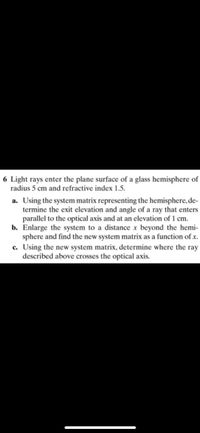Question

Transcribed Image Text:6 Light rays enter the plane surface of a glass hemisphere of
radius 5 cm and refractive index 1.5.
a. Using the system matrix representing the hemisphere, de-
termine the exit elevation and angle of a ray that enters
parallel to the optical axis and at an elevation of 1 cm.
b. Enlarge the system to a distance x beyond the hemi-
sphere and find the new system matrix as a function of x.
c. Using the new system matrix, determine where the ray
described above crosses the optical axis.
Expert Solution
This question has been solved!
Explore an expertly crafted, step-by-step solution for a thorough understanding of key concepts.
This is a popular solution
Trending nowThis is a popular solution!
Step by stepSolved in 5 steps with 15 images

Knowledge Booster
Similar questions
- A laser beam shines along the surface of a block of transparent material. (See the figure .) Half of the beam goes straight to a detector, while the other half travels through the block and then hits the detector. The time delay between the arrival of the two light beams at the detector is 6.10 ns. Part A What is the index of refraction of this material? n = -- ΑΣΦ Submit Request Answer ? n = ? -2.50 m- Detectorarrow_forwardA flat sheet of ice (n = 1.309) has a thickness of 2.7 cm. It is on top of a flat sheet of crystalline quartz (n = 1.544) that has a thickness of 1.5 cm. Light strikes the ice perpendicularly and travels through it and then through the quartz. In the time it takes the light to travel through the two sheets, how far (in cm) would it have traveled in a vacuum? Number i Unitsarrow_forward8. v The two mirrors in Figure P22.8 meet at a right angle. The beam of light in the vertical plane P strikes mirror 1 as shown. a. Determine the distance the reflected light beam travels before striking mirror 2. b. In what direction does the light beam travel after being reflected from mirror 2? Figure P22.8 Mirror 2 1.25 m 40.0° Mirror Parrow_forward
- 1. Roque is flying a kite along the dolomite sand of Manila Bay. If the string is 45 meters, determine the rate at which the angle of elevation is changing if the horizontal distance from him to the point directly below the kite is 13 m. Assume that he is running at a rate of 1.2 m/s; the kite is not swaying as it flies upward; and he started from rest when the kite is directly along his field of vision. A. 0.0923 rad/s B. 0.0279 rad/s C. 0.0222 rad/s D. None of these.arrow_forwardIn order to identify an unknown material you are asked to solve for the critical angle of the material. In order to test this you set up a beam of light that strikes the unknown substance from air (n = 1.0) at an angle of 30° with respect to the normal. It continues on in the substance at an angle of 23° with respect to the normal. What is the critical angle for the unknown substance? 51° 55° 60° 63°arrow_forwardSuppose you have an unknown clear substance immersed in water, and you wish to identify it by finding its index of refraction. You arrange to have a beam of light enter it at an angle of 45.0° with respect to the normal, and you observe the angle of refraction to be 40.3°. A. What is the index of refraction of the substance? B. What is its likely identity?arrow_forward
- A beam of light is incident from a liquid on the surface of transparent solid. The angle of incidence is 30°and the angle of refraction is 18°. Draw clear physics diagram of the problem – one for each part of the problem (3 total). label relevant angles. Find the critical angle for this solid when it is surrounded by the liquid. What is the angle between the reflected and refracted rays when the angle of incidence is 3°less than the critical angle?arrow_forwardLight traveling through medium 3 (n3 = 2.4) is incident on the interface with medium 2 (n2 = 2.0) at angle θ. If light does enter into medium 2 but no light enters into medium 1 (n1 = 1.6), what can we conclude about the range of values for θ?arrow_forwardaarrow_forward
arrow_back_ios
arrow_forward_ios